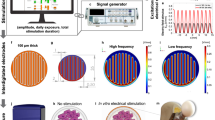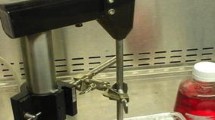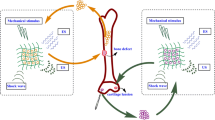Abstract
Purpose
The metabolic processes that regulate bone healing and bone induction in tissue engineering models are not fully understood. Eddy current excitation is widely used in technical approaches and in the food industry. The aim of this study was to establish eddy current excitation for monitoring metabolic processes during heterotopic osteoinduction in vivo.
Methods
Hydroxyapatite scaffolds were implanted into the musculus latissimus dorsi of six rats. Bone morphogenetic protein 2 (BMP-2) was applied 1 and 2 weeks after implantation. Weekly eddy current excitation measurements were performed. Additionally, invasive pH measurements were obtained from the scaffolds using fiber optic detection devices. Correlations between the eddy current measurements and the metabolic values were calculated.
Results
The eddy current measurements and pH values decreased significantly in the first 2 weeks of the study, followed by a steady increase and stabilization at higher levels towards the end of the study. The measurement curves and statistical evaluations indicated a significant correlation between the resonance frequency values of the eddy current excitation measurements and the observed pH levels (p = 0.0041).
Conclusions
This innovative technique was capable of noninvasively monitoring metabolic processes in living tissues according to pH values, showing a direct correlation between eddy current excitation and pH in an in vivo tissue engineering model.




Similar content being viewed by others
References
Calori GM, Mazza E, Colombo M, Ripamonti C (2011) The use of bone-graft substitutes in large bone defects: any specific needs? Injury 42(Suppl 2):S56–63. doi:10.1016/j.injury.2011.06.011
Tsiridis E, Upadhyay N, Giannoudis P (2007) Molecular aspects of fracture healing: which are the important molecules? Injury 38(Suppl 1):S11–25. doi:10.1016/j.injury.2007.02.006
Beck-Broichsitter BE, Christofzik DW, Daschner F, Knochel R, Smeets R, Warnke P, Wiltfang J, Becker ST (2012) Endocultivation: metabolism during heterotopic osteoinduction in vivo—monitoring with fiber optic detection devices. Tissue Eng Part C Methods 18(10):740–746. doi:10.1089/ten.TEC.2011.0641
Becker ST, Bolte H, Krapf O, Seitz H, Douglas T, Sivananthan S, Wiltfang J, Sherry E, Warnke PH (2009) Endocultivation: 3D printed customized porous scaffolds for heterotopic bone induction. Oral Oncol 45(11):e181–188. doi:10.1016/j.oraloncology.2009.07.004
Warnke PH, Bolte H, Schunemann K, Nitsche T, Sivananthan S, Sherry E, Douglas T, Wiltfang J, Becker ST (2010) Endocultivation: does delayed application of BMP improve intramuscular heterotopic bone formation? J Craniomaxillofac Surg 38(1):54–59. doi:10.1016/j.jcms.2009.09.002
Becker ST, Bolte H, Schunemann K, Seitz H, Bara JJ, Beck-Broichsitter BE, Russo PA, Wiltfang J, Warnke PH (2012) Endocultivation: the influence of delayed vs. simultaneous application of BMP-2 onto individually formed hydroxyapatite matrices for heterotopic bone induction. Int J Oral Maxillofac Surg 41(9):1153–1160. doi:10.1016/j.ijom.2012.03.031
Seitz H, Rieder W, Irsen S, Leukers B, Tille C (2005) Three-dimensional printing of porous ceramic scaffolds for bone tissue engineering. J Biomed Mater Res B Appl Biomater 74(2):782–788. doi:10.1002/jbm.b.30291
Hashizume H, Yamada Y, Miya K, Toda S, Morimoto K, Araki Y, Satake K, Shimizu N (1992) Numerical and experimental analysis of eddy current testing for a tube with cracks. IEEE Trans Magn 28:1469–1472
Conflict of interest
The authors negate any conflict of interest.
Source of funding
The authors negate any source of funding involved in this study.
Ethical approval
The study was approved by the German Animal Welfare Act (Animal Experiment Permit: V312-72241.121-14 (12-1/11)).
Author information
Authors and Affiliations
Corresponding author
Rights and permissions
About this article
Cite this article
Beck-Broichsitter, B.E., Daschner, F., Christofzik, D.W. et al. Using eddy currents for noninvasive in vivo pH monitoring for bone tissue engineering. Oral Maxillofac Surg 19, 55–60 (2015). https://doi.org/10.1007/s10006-014-0453-6
Received:
Accepted:
Published:
Issue Date:
DOI: https://doi.org/10.1007/s10006-014-0453-6




